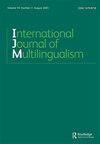Celebrating local heritage while marginalizing local language: the multilingual linguistic landscapes of Seongsu-dong in Seoul
IF 2
1区 文学
Q2 EDUCATION & EDUCATIONAL RESEARCH
引用次数: 0
Abstract
ABSTRACTThis study analyses the multilingual linguistic landscapes made up of languages, visual materials, and built environments in Seongsu-dong, where old industrial sites and new commercial places are indiscriminately juxtaposed. This study focuses particularly on (1) how languages are associated with different built environments of new commercial places and old industrial sites, (2) how the local industrial heritage is visually mobilised by new commercial places in ‘the pursuit of visibility’, and (3) how remaining industrial sites are both linguistically and visually marginalised. The languages, built environments, and visual materials, along with the users of the spaces, create contrasting semiotic aggregates. These aggregates expose the hierarchical tension between the commercial and the vernacular landscape in the neighbourhood. The commercial places highlight the local industrial heritage as globally trendy visual components, achieved through well-designed Roman alphabet letters or minimally inscribed Korean letters. This creates a cosmopolitan commercial landscape. In contrast, old industrial sites are filled with banal industrial texts in Korean, resulting in a vernacular landscape. The visual representation of the trendy industrial heritage, the use of Western-originating languages, and their cosmopolitan values combine to form a semiotic aggregate that reveals the underlying aspiration embedded in the town’s nickname, the Brooklyn of Seoul.KEYWORDS: Seoulsemiotic aggregatelinguistic landscapeindustrial heritagevernacular landscapemultilingualism Disclosure statementNo potential conflict of interest was reported by the author(s).Notes1 The origin of the nickname, the Brooklyn of Seoul, as well as the individual responsible for coining it, remains uncertain. However, the comparison to Brooklyn gained prominence as commercial spaces transformed from old warehouses started to appear in Seongsu-dong. This analogy gained traction in various forms of media, social media posts, and marketing materials.The nickname has also been officially used by the local government promoting the urban regeneration as the panel was installed by the local government in the subway station.在边缘化地方语言的同时颂扬地方遗产:首尔圣水洞的多语言景观
【摘要】本研究分析了圣水洞的语言、视觉材料和建筑环境构成的多语言景观,其中旧工业场地和新商业场所不分青红火火地并列在一起。本研究特别关注(1)语言如何与新商业场所和旧工业场所的不同建筑环境相关联;(2)新商业场所如何在“追求可见性”的过程中调动当地的工业遗产;(3)剩余的工业场所如何在语言和视觉上被边缘化。语言、建筑环境和视觉材料,以及空间的使用者,创造了对比鲜明的符号学集合。这些集合体揭示了商业和当地景观之间的等级紧张关系。商业场所通过精心设计的罗马字母或最小镌刻的韩国字母,突出了当地工业遗产作为全球时尚的视觉组成部分。这创造了一个世界性的商业景观。相比之下,旧工业场地充斥着韩国的陈腐工业文本,形成了乡土景观。时尚工业遗产的视觉表现,源自西方语言的使用,以及它们的世界主义价值观结合在一起,形成了一个符号学的集合,揭示了这个小镇昵称“首尔的布鲁克林”所蕴含的潜在愿望。关键词:首尔符号学总体语言景观工业遗产乡土景观多元语言披露声明作者未发现潜在的利益冲突。注1首尔的布鲁克林这个绰号的起源,以及这个绰号的创造者是谁,目前仍不清楚。然而,随着圣水洞开始出现由旧仓库改造而成的商业空间,与布鲁克林的比较变得更加突出。这种类比在各种形式的媒体、社交媒体帖子和营销材料中得到了关注。这个绰号也被当地政府正式使用,以促进城市更新,因为当地政府在地铁站安装了面板。
本文章由计算机程序翻译,如有差异,请以英文原文为准。
求助全文
约1分钟内获得全文
求助全文
来源期刊

International Journal of Multilingualism
Multiple-
CiteScore
6.10
自引率
8.70%
发文量
67
期刊介绍:
The aim of the International Journal of Multilingualism (IJM) is to foster, present and spread research focused on psycholinguistic, sociolinguistic and educational aspects of multilingual acquisition and multilingualism. The journal is interdisciplinary and seeks to go beyond bilingualism and second language acquisition by developing the understanding of the specific characteristics of acquiring, processing and using more than two languages. The International Journal of Multilingualism (IJM) provides a forum wherein academics, researchers and practitioners may read and publish high-quality, original and state-of-the-art papers describing theoretical and empirical aspects that can contribute to advance our understanding of multilingualism.Topics of interest to IJM include, but are not limited to the following: early trilingualism, multilingual competence, foreign language learning within bilingual education, multilingual literacy, multilingual identity, metalinguistic awareness in multilinguals, multilingual representations in the mind or language use in multilingual communities. The editors encourage the submission of high quality papers on these areas as well as on other topics relevant to the interest of the International Journal Multilingualism (IJM). Reviews of important, up-to-date, relevant publications and proposals for special issues on relevant topics are also welcome.
 求助内容:
求助内容: 应助结果提醒方式:
应助结果提醒方式:


